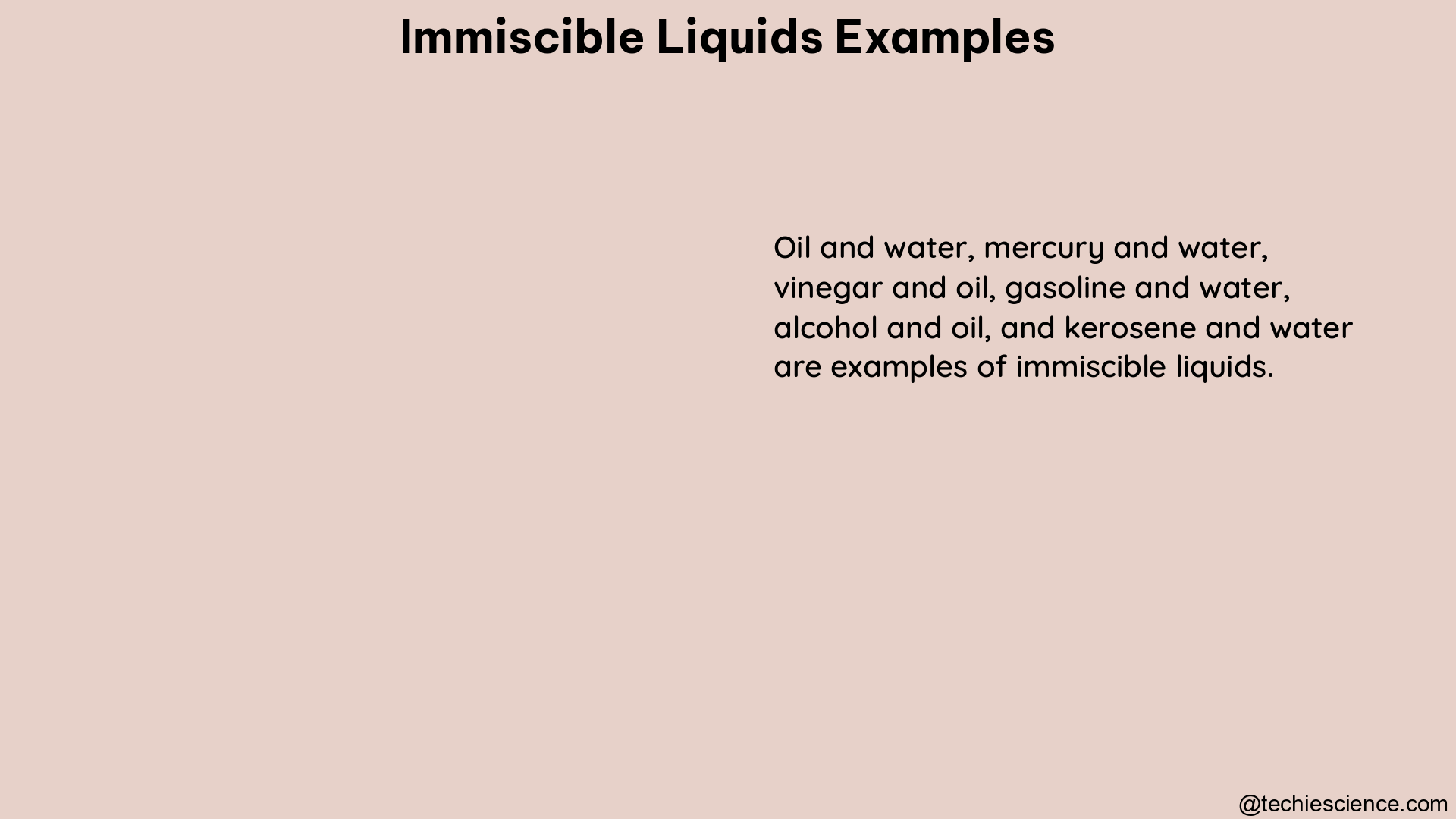Immiscible liquids are liquids that do not mix to form a homogeneous solution. These liquids exhibit unique behaviors due to their inability to mix, and their properties have been extensively studied using various experimental and theoretical methods. In this comprehensive guide, we will explore the fascinating world of immiscible liquids, delving into their characteristics, applications, and the latest research findings.
Understanding Immiscible Liquids
Immiscible liquids are characterized by their inability to form a single, uniform phase when mixed. Instead, they separate into distinct layers, with each liquid maintaining its own unique properties. This behavior is primarily determined by the density and polarity of the liquids involved.
One of the most common examples of immiscible liquids is the combination of oil and water. Oil, being less dense than water, floats on the surface, creating a distinct separation between the two liquids. This property has numerous applications, such as in the oil and gas industry, where it is used to separate oil from water during the extraction and refining processes.
Density and Immiscibility

The density of liquids plays a crucial role in their immiscibility. Liquids with significantly different densities are more likely to remain separate when mixed. This is because the denser liquid will typically sink to the bottom, while the less dense liquid will float on top.
Experimental studies have been conducted to measure the liquid densities of various n-alkanes, such as n-pentane, n-hexane, and n-heptane, and their binary mixtures. These measurements were performed over a wide range of temperatures, from 273.15 K to 363.15 K, at atmospheric pressure. The results showed that the Tait equation, a generalized correlation, could accurately predict the liquid densities of n-alkanes and their mixtures, with an average percentage deviation of only 0.15% from the experimental data.
Morphology Development in Immiscible Polymer Blends
In the field of polymer science, the study of immiscible polymer blends has revealed fascinating insights into the development of various morphological structures. These structures include droplet-matrix, fibrillar, and cocontinuous structures, each with its own unique characteristics and applications.
Droplet-matrix structures are formed when one polymer is dispersed as small droplets within a continuous matrix of the other polymer. The dynamics of these droplet-matrix structures have been extensively studied, providing valuable information about the behavior of immiscible polymer blends.
Fibrillar structures, on the other hand, are characterized by the formation of elongated, thread-like structures within the polymer blend. The dynamics of these fibrillar structures have also been investigated, shedding light on the complex interactions between the immiscible polymers.
Cocontinuous structures, where both polymers form interconnected networks, have also been observed in immiscible polymer blends. The study of these structures has provided insights into the phase separation and morphology development processes in such systems.
Density Profiles at the Liquid-Liquid Interface
The structure of the interface between two immiscible liquids has been studied using density-functional theory and molecular-dynamics calculations. These studies have revealed interesting insights into the density profiles of the liquids at the interface.
The density profiles of the liquids displayed oscillations only in a limited part of the simple liquid-phase diagram (ρ, T). As the system approached the liquid-vapor coexistence, a significant depletion in the density profile was observed, while the layering behavior of the density profile vanished. These findings highlight the complex and dynamic nature of the interface between immiscible liquids.
Quantifying Immiscible Liquids in Sand-Clay Mixtures
NMR (Nuclear Magnetic Resonance) relaxation measurements have been employed to quantify the presence of immiscible, organic liquids in sand-clay mixtures. This method is based on the fact that the relaxation times of protons in a liquid depend on the mobility of the molecules, which is affected by the presence of other phases.
Since the relaxation times of protons in immiscible liquids are different, this technique allows for the quantification of these liquids in complex, heterogeneous systems, such as sand-clay mixtures. This approach has proven valuable in various applications, including environmental monitoring and remediation.
Conclusion
Immiscible liquids exhibit a fascinating array of behaviors and properties that have been extensively studied using a variety of experimental and theoretical methods. From the role of density in determining immiscibility to the complex morphological structures observed in polymer blends, and the insights gained from density profiles at liquid-liquid interfaces, this comprehensive guide has explored the diverse aspects of immiscible liquids.
As research in this field continues to evolve, we can expect to see further advancements in our understanding of these unique systems and their applications across various industries, from oil and gas to environmental remediation and beyond.
References:
- Experimental Liquid Densities for n-Pentane, n-Hexane, and n-Heptane and Their Binary Mixtures
- Quantifying Immiscible, Organic Liquids in Sand-Clay Mixtures Using NMR Relaxation Measurements
- Hazardous Waste Characteristics

The lambdageeks.com Core SME Team is a group of experienced subject matter experts from diverse scientific and technical fields including Physics, Chemistry, Technology,Electronics & Electrical Engineering, Automotive, Mechanical Engineering. Our team collaborates to create high-quality, well-researched articles on a wide range of science and technology topics for the lambdageeks.com website.
All Our Senior SME are having more than 7 Years of experience in the respective fields . They are either Working Industry Professionals or assocaited With different Universities. Refer Our Authors Page to get to know About our Core SMEs.